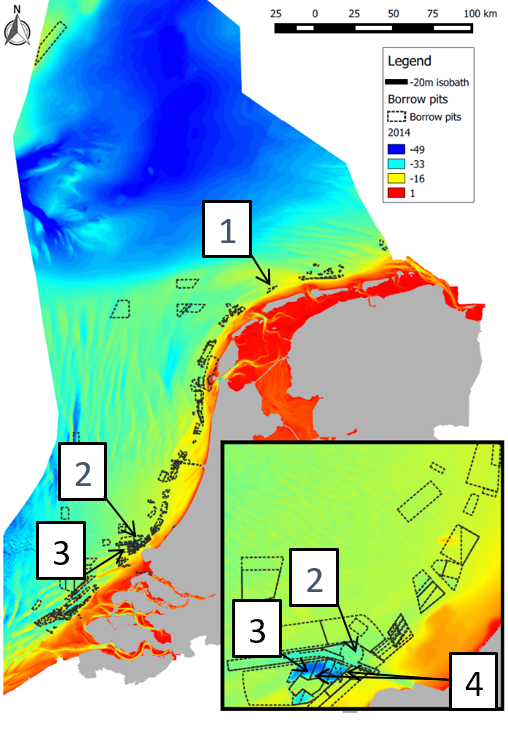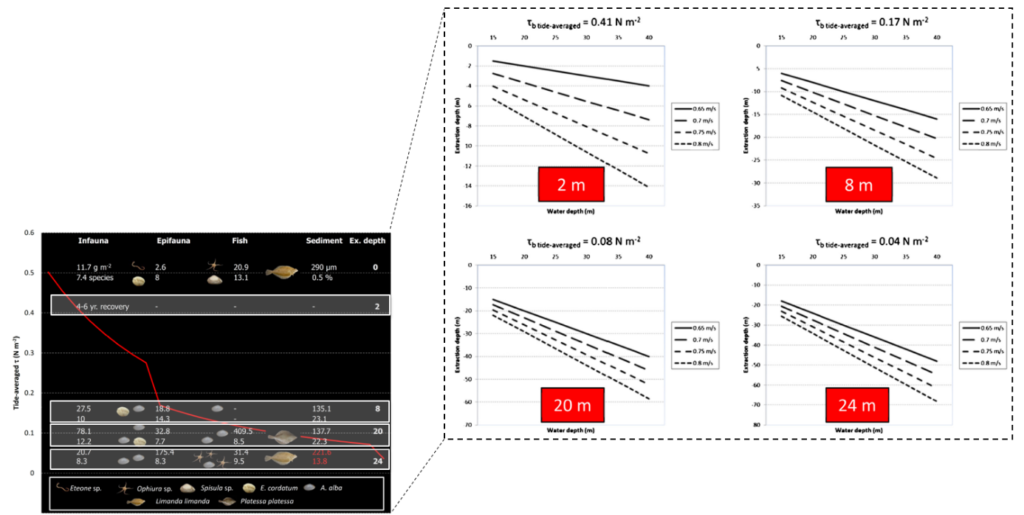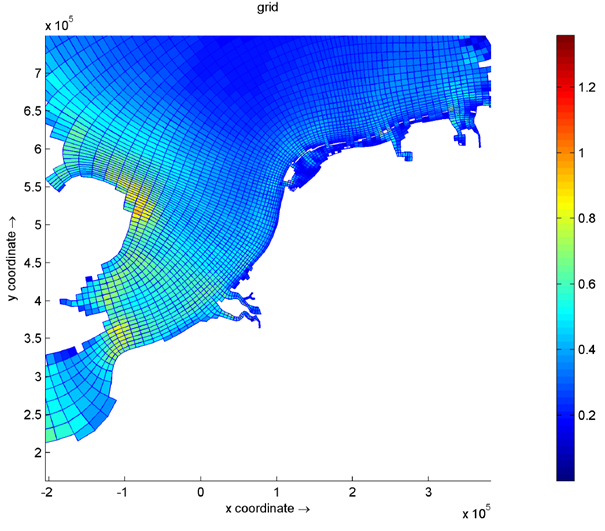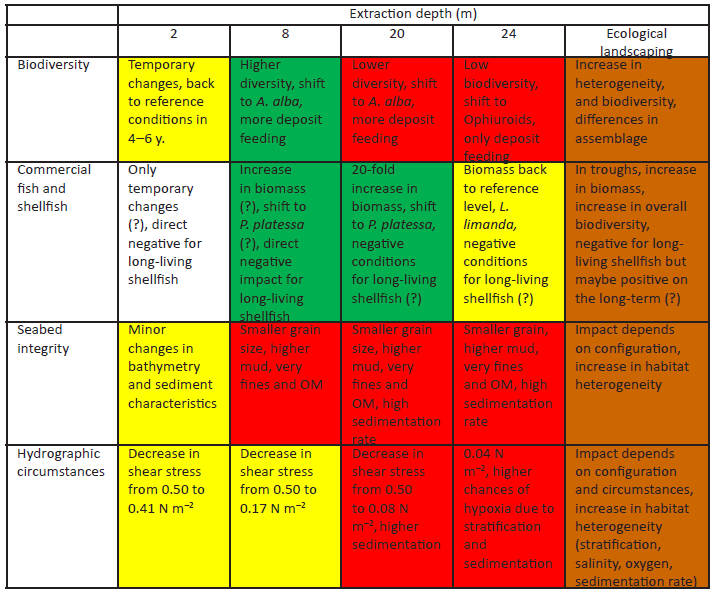How to Use
Ecosystem-based design (EBD) rules for sand extraction sites
The short-term effects of deep sand extraction (20 – 24 m) are compared with other case studies such as, regular shallow sand extraction on the Dutch Continental Shelf (DCS) (2 m) and an 8-m deepened shipping lane. For intercomparing between case studies, we used tide-averaged bed shear stress as a generic proxy for environmental and related ecological effects. Bed shear stress ( ) can be estimated with a two-dimensional quadratic friction law and showed a decrease from 0.50 to 0.04 N m−2 in a sand extraction site in 20 m deep water and extraction depths up to 24 m.


g = gravitational acceleration
U = Depth-averaged flow velocity (Fig. 12)
C = Chézy coefficient
Macrozoobenthos in a sand extraction site with a tide-averaged bed shear stress of around 0.41 N m–2 on the DCS is expected to return to pre-extraction conditions within 4–6 year (De Jong et al., 2016; van Dalfsen et al., 2000; van Dalfsen and Essink, 2001). When tide-averaged bed shear stress decreases below 0.17 N m−2 on the DCS enhanced macrozoobenthic species richness and biomass may occur. Below a tide-averaged bed shear stress of 0.08 N m−2 on the DCS increasing abundance and biomass of brittle stars, white furrow shell (Abra alba) and plaice (Platessa platessa) can be expected. Below 0.04 N m−2, an overdominance and high biomass of brittle stars can be expected whereas demersal fish biomass and species composition may return to reference conditions. Next to changes in faunal composition, a high sedimentation rate can be expected.
Ecological data and bed shear stress values were transformed into ecosystem-based design (EBD) rules for the DCS. At higher flow velocities and larger water depths, larger extraction depths can be applied to achieve desired tide-averaged bed shear stresses for related ecological effects (De Jong et al., 2016).

Left panel: Data on infauna (biomass in g m-2, number of species and dominant species), epifauna (biomass in g m-2, number of species and dominant species), fish (biomass in g m-2, number of species and dominant species), sediment (grain size in µm, volume percentage of fines) and extraction depth (0, 2, 8, 20, 24 m below the seabed). The red line is the estimated bed shear stress of the case studies 1: 20 m deep regions without sand extraction, 2: shallow sand extraction (2 m) near barrier island Terschelling, 3: intermediate deep sand extraction (8 m) in the turning basin of the Euromaasgeul shipping lane, 4: deep sand extraction (20 and 24 m). Right panel: Calculated extraction depths needed to reach bed shear stress values of each case study (2 m: 0.41, 8 m: 0.17, 20 m: 0.08 and 24 m: 0.04 N m-2), for areas with different depth averaged flow velocity (solid lines: 0.65, large-dash lines: 0.7, intermediate- dash lines: 0.75 and small dash lines: 0.8 m s-1) and initial water depth at the x-axes (15, 25, 30, 35, 40 m).

The Ecosystem Based Design (EBD) rules can be used in the early-design phases of future sand extraction sites to simultaneously maximise sand yields and decrease the surface area of direct impact. The EBD rules and ecological landscaping can also help in implementing the European Union’s Marine Strategy Framework Directive (MSFD) guidelines and moving to or maintaining Good Environmental Status (GES).

Lessons Learned and Recommendations
The development of Ecosystem-based Design Rules for Sand Extraction Sites, being based on studies on short- and medium term effects of sand extraction sites on the Dutch Coastal Shelf, has provided the following lessons.
- Sediment disposal and deep sand extraction have the potential to significantly alter biomass and species composition of macrozoobenthos living in and on the seabed;
- Sediment characteristics and bed shear stress influence macrozoobenthos but large ‘year-to-year’ variation is also present;
- 5 in- and epifaunal assemblages are detected in the coastal zone in front of Port of Rotterdam
- Large scale and deep sand extraction for MV2 significantly influenced demersal fish species composition (plaice instead of dab) and biomass increased up to 20-fold;
- Macrozoobenthos species composition changed significantly and white furrow shell became the most abundant species, biomass values increased 5-fold;
- Ecological landscaping can alter macrozoobenthos and demersal fish (species composition and biomass) and can be used to increase habitat heterogeneity;
- Ecosystem-based design rules based on ecological data and estimated bed shear stress values can be used to maximise sand yield, minimize the impacted surface area with a on beforehand known ecological response;
- With increasing sand extraction depths → decreasing bed shear stress values → increasing the chance of fine sediment accumulation → change in macrozoobenthos and demersal fish → longer recovery time back to the pre-dredge state.
- Ecosystem-based design rules can play a role in the Marine Strategy Framework directive (MSFD) which are currently implemented by European states.
Considering the context of the studies, on which the design rules are based, further confirmation of the validity and applicability of these rules in general can be obtained through
- Investigation of medium and long term effects of deep and large-scale sand extraction and ecological landscaping;
- Investigation of shallow and intermediate deep sand extraction on the Dutch Continental Shelf (DCS);
- Validation of ecosystem-based design rules on the DCS and beyond;
- Investigation of the application of ecosystem-based design rules and ecological landscaping outside the DCS. A paper about the applicability of the ecosystem-based design rules outside the Dutch Continental Shelf is currently under review at the peer-reviewed journal “Hydrobiologia” (de Jong et al., n.d.).
